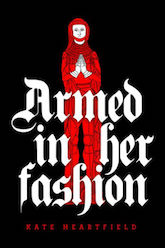Armed in Her Fashion is Kate Heartfield’s debut novel, and what a strange, compelling, genre-bending debut it is. Part horror, part fantasy, part history, and part epic, it combines all of its elements into a commentary on gender, power, and patriarchy. It centres around several women (and one man) who want in their own ways to have their due.
That makes it sound deeply serious. Actually, it’s enormously fun.
Buy the Book


Armed in Her Fashion
The year is 1328. Bruges is under siege, but not by any ordinary army. The Chatelaine of Hell wants the King of France to give her Flanders to rule, and she’s recruited an army of chimeras—humans combined with animals or armour in the forges of Hell—to assault its walls. Hell is a beast, and the Chatelaine holds its reins and its keys, ever since she locked away her husband: she wants, it seems, the power to never need be afraid of anything again. By day, Bruges faces chimeras and mercenaries: by night, revenants who crawl over the walls to bring plague and madness to the inhabitants.
Armed in Her Fashion follows three major characters apart from the Chatelaine of Hell. Margriet de Vos learns she’s a widow when her revenant husband comes back from the war to reclaim a secret hoard of coin and weapons from underneath her floorboards, and heads back towards the mouth of Hell. Margriet’s buried six of her seven children, and she’s bound and determined to get her last surviving daughter’s inheritance back. Even if that means walking into hell to petition the Chatelaine to respect a widow’s rights.
Beatrix is Margriet’s daughter. Her personality comes across less strongly in the novel’s pages: she’s milder, and more conflicted, for she actually loved the husband who now haunts her as a revenant. And she’s blessed—or afflicted—with a distaff that lets her influence the revenants and gives her visions of the future. Margriet brings Beatrix with her out of Bruges before it falls to the Chatelaine’s forces, on a medieval wartime roadtrip to get their rightful due.
Also carried along by Margriet’s determination is Claude, a man-at-arms who found himself inside Bruges after fleeing the Chatelaine. Claude in Bruges is very distressed, as he’s been injured and fetched up in the care of people who (a) he was fighting and (b) who insist he wear women’s clothes, since they see him as a woman—which he isn’t, and he hasn’t had to live as one since he ran away to join a mercenary company in his youth. And adding to that distress, he longs for the enchanted weapon that allowed him escape Hell: a weapon that distorted his swordarm and means the Chatelaine intends to pursue him, because it’s a weapon that can open all the locks of Hell itself. But Claude’s a soldier, and he’s willing to help Margriet if it means he can get his weapon back.
Meanwhile, the Chatelaine is trying to convince the King of France to reward her with the lands she so very much wants. Margriet and her company put a spoke in her hopes, though, because the King of France seizes on the opportunity to have a bishop rule on the matter of whether or not a revenant is actually dead, and thus whether or not Margriet and Beatrix are actually widows. This is the kind of novel that has baroque horrors and a canon law court case—as well as desperate pursuits, the horrors of the battlefield, and an armed raid on Hell itself.
Heartfield’s characters are compelling and believable—and believably medieval in their outlooks. They present a realistically representative cross-section of a possible medieval world, from a Jewish man-at-arms to a Moorish widow of a city alderman. Heartfield draws her world with understated competence, creating a 14th-century Flanders that is home to a weirdly organic entrance to Hell. Heartfield’s Hell-as-beast, as living organism, recollects the organic horrors of Simon R. Green’s Deathstalker books or the fiction of Kameron Hurley. It’s a baroque yet squishy infernal realm—a novel piece of invention.
Heartfield’s prose is economical. Plain and unadorned, but effortlessly readable, it drives the reader on through this grim muddy Flanders that holds glimpses of other magics than Hell: a serpent in the canals of Bruges whose service a younger Margriet won by her cleverness; Beatrix’s distaff; the honorable unicorn-man (Monoceros) who serves the Chatelaine. The pacing mounts effectively towards courtroom confrontation and explosive (literally) conclusion, and the ending feels both surprising and inevitable, as the best endings always do.
I really enjoyed Armed in Her Fashion. It’s worth reading. I may, in fact, need to read it again: there are interesting layers in the thematic work that Heartfield’s doing, and I’m not convinced I caught them all in one sitting.
In other words, I recommend it.
Armed in Her Fashion is available from ChiZine.
Liz Bourke is a cranky queer person who reads books. She holds a Ph.D in Classics from Trinity College, Dublin. Her first book, Sleeping With Monsters, a collection of reviews and criticism, was published in 2017 by Aqueduct Press. It’s a Locus Award finalist as well as nominated for a Hugo Award in Best Related Work. Find her at her blog, where she’s been known to talk about even more books thanks to her Patreon supporters. Or find her at her Twitter. She supports the work of the Irish Refugee Council and the Abortion Rights Campaign.










